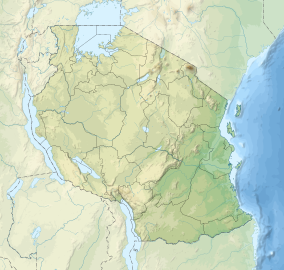Tarangire National Park
| Tarangire National Park | |
|---|---|
IUCN category II (national park) | |
 | |
 | |
| Location | Tanzania |
| Nearest city | Arusha |
| Coordinates | 3°50′S 36°0′E / 3.833°S 36.000°E / -3.833; 36.000Coordinates: 3°50′S 36°0′E / 3.833°S 36.000°E / -3.833; 36.000 |
| Area | 2,850 km2 (1,100 sq mi) |
| Established | 1970 |
| Visitors | 161,792 (in 2012[1]) |
| Governing body | Tanzania National Parks Authority |
| Website | www.tanzaniaparks.go.tz |
Tarangire National Park is the sixth largest national park in Tanzania, it is located in Manyara Region. The name of the park originates from the Tarangire River that crosses the park. The Tarangire River is the primary source of fresh water for wild animals in the Tarangire Ecosystem during the annual dry season. The Tarangire Ecosystem is defined by the long-distance migration of wildebeest and zebras. During the dry season thousands of animals concentrate in Tarangire National Park from the surrounding wet-season dispersal and calving areas.
It covers an area of approximately 2,850 square kilometers (1,100 square miles.) The landscape is composed of granitic ridges, river valley, and swamps. Vegetation is a mix of Acacia woodland, Commiphora-Combretum woodland, seasonally flooded grassland, and Baobab trees.
Contents
1 Flora and fauna
2 Location and access
3 Properties and lodges
4 References
5 External links
Flora and fauna
The park is famous for its high density of elephants and baobab trees. Visitors to the park in the June to November dry season can expect to see large herds of thousands of zebra, wildebeest and cape buffalo. Other common resident animals include waterbuck, giraffe, dik dik, impala, eland, Grant's gazelle, vervet monkey, banded mongoose, and olive baboon. Predators in Tarangire include lion, leopard, cheetah, caracal, honey badger, and African wild dog.
The oldest known elephant to give birth to twins is found in Tarangire. A recent birth of elephant twins in the Tarangire National Park of Tanzania is a great example of how the birth of these two healthy and thriving twins can beat the odds.[2]
Home to more than 550 bird species, the park is a haven for bird enthusiasts. The park is also famous for the termite mounds that dot the landscape. Those that have been abandoned are often home to dwarf mongoose. In 2015, a giraffe that is white due to leucism was spotted in the park.[3] Current wildlife research projects in the park include the Tarangire Elephant Project, Tarangire Lion Project, and Masai Giraffe Conservation Demography Project.

Tree climbing lion at Tarangire National Park
Since 2005, the protected area is considered a Lion Conservation Unit.[4]
Location and access
Tarangire National Park can be reached via paved road south from Arusha in under two hours. Lake Manyara National Park is a 70 kilometer (43 mile) drive from Tarangire.
Properties and lodges
(listed alphabetically)[5]
- Nomad Tanzania
- Little Oliver's
- Oliver's Camp
- Sanctuary Retreats
- Sopa Lodges
- Nasikia Camps
- Tarangire Safari Lodge
References
^ "Tanzania National parks Corporate Information". Tanzania Parks. TANAPA. Archived from the original on 20 December 2015. Retrieved 22 December 2015..mw-parser-output cite.citation{font-style:inherit}.mw-parser-output q{quotes:"""""""'""'"}.mw-parser-output code.cs1-code{color:inherit;background:inherit;border:inherit;padding:inherit}.mw-parser-output .cs1-lock-free a{background:url("//upload.wikimedia.org/wikipedia/commons/thumb/6/65/Lock-green.svg/9px-Lock-green.svg.png")no-repeat;background-position:right .1em center}.mw-parser-output .cs1-lock-limited a,.mw-parser-output .cs1-lock-registration a{background:url("//upload.wikimedia.org/wikipedia/commons/thumb/d/d6/Lock-gray-alt-2.svg/9px-Lock-gray-alt-2.svg.png")no-repeat;background-position:right .1em center}.mw-parser-output .cs1-lock-subscription a{background:url("//upload.wikimedia.org/wikipedia/commons/thumb/a/aa/Lock-red-alt-2.svg/9px-Lock-red-alt-2.svg.png")no-repeat;background-position:right .1em center}.mw-parser-output .cs1-subscription,.mw-parser-output .cs1-registration{color:#555}.mw-parser-output .cs1-subscription span,.mw-parser-output .cs1-registration span{border-bottom:1px dotted;cursor:help}.mw-parser-output .cs1-hidden-error{display:none;font-size:100%}.mw-parser-output .cs1-visible-error{font-size:100%}.mw-parser-output .cs1-subscription,.mw-parser-output .cs1-registration,.mw-parser-output .cs1-format{font-size:95%}.mw-parser-output .cs1-kern-left,.mw-parser-output .cs1-kern-wl-left{padding-left:0.2em}.mw-parser-output .cs1-kern-right,.mw-parser-output .cs1-kern-wl-right{padding-right:0.2em}
^ "Trunk Twins : Elephant Twins Born in Tarangire | Asilia Africa". Asilia Africa. 2018-04-06. Retrieved 2018-04-06.
^ Tom Hale (January 26, 2016). "Incredibly Rare White Giraffe Spotted In Tanzania". Retrieved 2016-01-27.
^ IUCN Cat Specialist Group (2006). Conservation Strategy for the Lion Panthera leo in Eastern and Southern Africa. Pretoria, South Africa: IUCN.
^ Tarangire National Park
External links
| Wikimedia Commons has media related to Tarangire. |
- Official website
- World Conservation Monitoring Centre
This Tanzania location article is a stub. You can help Wikipedia by expanding it. |
This Africa protected areas related article is a stub. You can help Wikipedia by expanding it. |